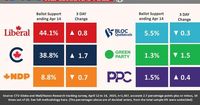As the Canadian federal election campaign enters its final stretch, recent polling data reveals a tightening race between the incumbent Liberal Party and the Conservative Party of Canada (CPC). According to an Angus Reid Institute poll published on April 14, 2025, support for the Liberals stands at 45 percent, while the Conservatives have seen a slight uptick, bringing their support to 39 percent. This marks a significant moment in the campaign, as the CPC appears to be gaining momentum just weeks before election day.
The tightening of the race can be attributed to several factors, notably shifting voter concerns and the evolving perceptions of party leaders. Chief among these concerns is the rising cost of living and inflation, which has surged to 56 percent among voters' top issues. In contrast, worries regarding tariff threats and the Trump-Canada relationship have decreased by 12 points over the past month, indicating a shift in voter priorities.
Prime Minister Mark Carney's personal momentum has also reached a neutral pace, with a recent survey indicating that 33 percent of Canadians feel his opinion has improved, while 31 percent believe it has worsened. This stagnation comes after a period of increased positive impressions for Carney, who still holds a favorable advantage over CPC leader Pierre Poilievre and NDP leader Jagmeet Singh, both of whom are experiencing negative momentum.
Interestingly, the CPC has regained the lead among male voters, particularly those aged 54 and older, where they now hold a seven-point advantage. This shift marks a notable turnaround from the early campaign period, during which many men appeared to be reconsidering their support for the Liberals following Justin Trudeau's departure.
In British Columbia, the race has tightened significantly, with Poilievre campaigning actively in the region, including rallies in Penticton and Terrace, where he promised to accelerate oil and gas projects if elected. Meanwhile, Carney has been focusing his efforts on maintaining Liberal support in Ontario, where the party leads the Conservatives by a solid ten points.
Despite the tightening race, the Liberal Party continues to maintain a strong presence in Quebec, where they enjoy a 12-point lead over the Bloc Québécois. However, the CPC is making inroads in urban areas, particularly in Toronto, where they have regained some support.
As the campaign progresses, the gender gap remains a prominent feature of voter preferences. The CPC has made gains among male voters, while women continue to show significant support for the Liberals. This divergence could play a crucial role in determining the election outcome.
Voter commitment also presents a complex picture. Approximately 75 percent of CPC supporters express unwavering loyalty, translating to about 30 percent of the electorate. In contrast, 63 percent of Liberal voters report high levels of commitment, representing around 28 percent of the electorate. This discrepancy suggests that while the Liberals have a higher potential ceiling, their base may be less stable.
Among uncommitted voters, many express an openness to new developments, with nearly half indicating they wish to keep an open mind. A significant portion is also awaiting the upcoming debates, which could influence their final decision.
As the debates approach, experts note that party leaders are likely engaging in rigorous preparation. Dan Arnold, chief strategy officer at Pollara, emphasized the importance of body language and communication strategies during these critical events. Carney, who has faced scrutiny over his French language skills, is reportedly working to improve his delivery in both English and French.
The debates will cover a range of pressing topics, including the cost of living, energy, climate, immigration, and public safety. Arnold remarked that the effectiveness of each leader’s presentation could significantly impact their standing with voters.
In terms of regional support, the Liberals continue to dominate in Ontario, Atlantic Canada, Quebec, and British Columbia, while the Conservatives maintain a stronghold in the Prairies. In Ontario, the Liberals are polling at 51 percent, with the Conservatives trailing at 40 percent. Conversely, in the Prairies, Conservative support remains robust at 60 percent, compared to just 26 percent for the Liberals.
As of April 15, 2025, a Leger poll indicated that 44 percent of Canadians would vote Liberal, while 37 percent would support the Conservatives, and 8 percent favor the NDP. Notably, 61 percent of Canadians report having already made up their minds about their voting intentions.
Looking ahead, the upcoming debates will provide a pivotal opportunity for leaders to connect with voters and potentially sway undecided constituents. With just two weeks remaining until election day, the stakes are high for all parties involved.
As the campaign unfolds, it remains to be seen whether the CPC can capitalize on its recent gains and whether the Liberals can maintain their lead amidst shifting voter concerns. The next few days will be crucial as party leaders prepare to face off in debates that could reshape the electoral landscape.





